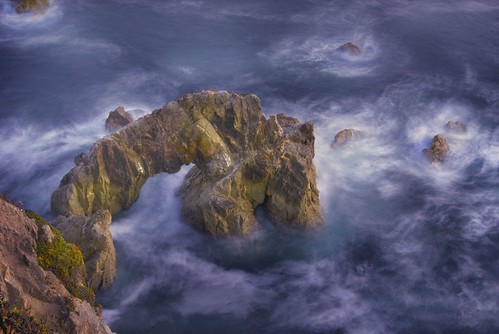In a significant way, photography is about time. A photograph freezes action and captures a moment. Looking at photographs we see the past, perhaps our past. Photographs become memories. Unlike the wizard photos in Harry Potter’s world, the people in our photos don’t move around to get our attention. The time slice is static, and the time capture is usually created with shutter speeds that are a small fraction of a second.
View this image larger. Read the back story featuring this image.
When shutter speeds get longer, and are measured in seconds or even minutes, then the capture of time changes. Moving cars become streaks of light and people are featureless blurs (unless they hold really, really still like they did at the beginnings of photography). Water in motion becomes ethereal, like the action of the surf in the photo above and below. The waves crashing on the rocks have been tamed and gentled. The rock and arch almost look like mountain peaks peering through clouds.
View this image larger. Read the back story featuring this image.
In both these pictures, I combined two exposures. Each exposure used the same aperture (f-stop). I used twice as long a shutter speed for the rocks as I did for the surf. I combined the exposures manually in Photoshop using layers, masking, and blending modes. This is not exactly High-Dynamic Range processing, as I explain in Multi-Raw Processing Versus Automated HDR.
The photographic trick is to absolutely and completely not move the camera between the two exposures. A tripod is, of course, required. But absolute camera stillness can be harder than one thinks it will be, particularly when the fierce wind that drives the surf is raging. Even the slightest motion of the camera will show up as a registration problem when you try to combine the layers. A solution can be to anchor your tripod with something heavy (like your camera bag).

